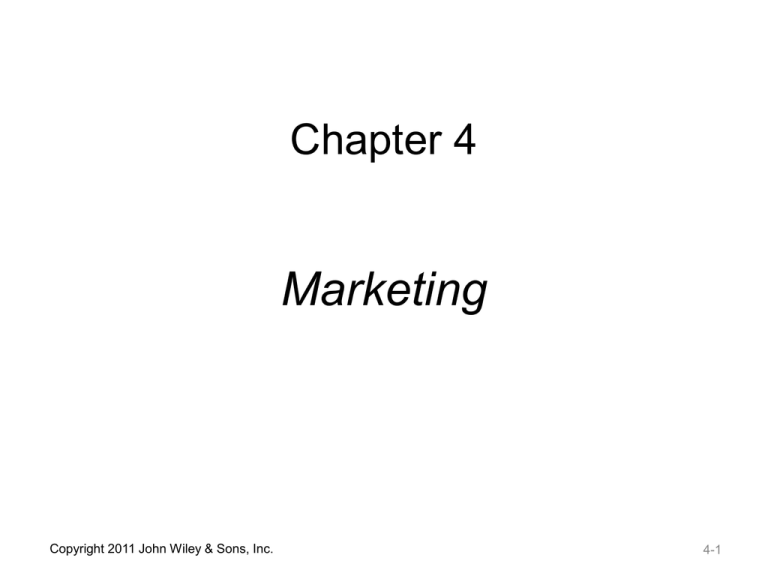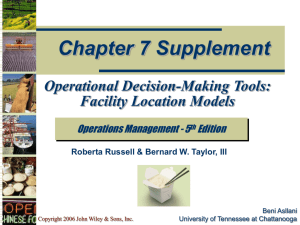
Chapter 4
Marketing
Copyright 2011 John Wiley & Sons, Inc.
4-1
Lecture Outline
• What is Marketing?
• Customer-Driven Supply Chains
• Delivering Value to Customers
• Channels of Distribution
Copyright 2011 John Wiley & Sons, Inc.
4-2
What is Marketing?
Marketing is the function responsible for linking
the organization to its customers and is
concerned with the “downstream” part of the
supply chain
Copyright 2011 John Wiley & Sons, Inc.
4-3
Copyright 2011 John Wiley & Sons, Inc.
4-4
The Marketing Function
Marketing Task:
– identify what customers want and need
– create demand for a company’s current and
new products
– identify market opportunities
Copyright 2011 John Wiley & Sons, Inc.
4-5
Marketing Segmentation
Marketing segmentation distinguishes markets
• Mass Marketing
– treats the entire market as a homogenous group
• Target Marketing
– does not try to please all customers with the
same product
Copyright 2011 John Wiley & Sons, Inc.
4-6
Evolution of Marketing
Copyright 2011 John Wiley & Sons, Inc.
4-7
Evolution of Marketing Continued
• Three Perspectives:
– Production Concept
– Selling Concept
– Marketing Concept
• Two Eras:
– Transactional Marketing
– Relational Marketing
Copyright 2011 John Wiley & Sons, Inc.
4-8
Evolution of Marketing -The Production Concept
The Production Concept dominated the early
part of the 20th Century
– unfulfilled demand for products
– products easily sold
– challenge to sell at a price that
exceeded the cost
Copyright 2011 John Wiley & Sons, Inc.
4-9
Evolution of Marketing -The Selling Concept
The Selling Concept dominated the middle of
the 20th century
– increased competition
– mass production was commonplace
– less unfulfilled demand
– marketing used to persuade customers
– little attention to customers needs
Copyright 2011 John Wiley & Sons, Inc.
4-10
Evolution of Marketing -The Marketing Concept
The Marketing Concept began in the 1970s
– greater product variety and customer
selectiveness
– increased discretionary income
– increasingly global environment
– focus on identifying customers needs
and keeping customers satisfied
Copyright 2011 John Wiley & Sons, Inc.
4-11
Evolution of Marketing -Transactional Marketing Era
The Marketing perspectives prior to the 1970s
were part of the era of Transactional Marketing
– focus on obtaining successful exchanges with
customers
– sell existing products using promotional
techniques
– Production and Selling Concept marketing
perspective eras
Copyright 2011 John Wiley & Sons, Inc.
4-12
Evolution of Marketing -Relational Marketing Era
The Marketing Concept perspective beginning
in the 1970s is a part of the era of Relational
Marketing
– focus on building long-term relationships
– marketing research
– cost-effective to retain current customers
Copyright 2011 John Wiley & Sons, Inc.
4-13
Impact on the Organization
• Marketing brings the voice of the
customer into the decision making
process of the company
• Customer desires are then translated
into viable and profitable products
Copyright 2011 John Wiley & Sons, Inc.
4-14
Marketing Decisions
Marketing decisions fall into four categories:
• Product
• Price
• Place (Distribution)
• Promotion
These decisions directly involve SCM
Copyright 2011 John Wiley & Sons, Inc.
4-15
Customer-Driven Supply Chains
An empowered customer is the driving force of
the supply chain
• Knowledgeable buyers
– product choices, costs, consumer reviews
• Buyers demand choices in products and
services
– shift in power from companies to customers
Copyright 2011 John Wiley & Sons, Inc.
4-16
Who is the Customer?
Typically there are two types of end users:
• End Customer
– purchases are made by an individual or
household to satisfy personal needs
• Organizational End User
– purchases are made by an organization in
order for employees to perform their jobs
Copyright 2011 John Wiley & Sons, Inc.
4-17
Types of Customer Relationships
Common strategies used to satisfy customers
in target markets:
• Standardized Strategy
• Customized Strategy
• Niche Strategy
• Micro-Marketing
Copyright 2011 John Wiley & Sons, Inc.
4-18
Standardized Strategy
– All customers are viewed in the same way
– Minimal product customization
– Products developed for the average customer
– Cost advantages
Copyright 2011 John Wiley & Sons, Inc.
4-19
Customized Strategy
– Utilizes information from market segmentation
– Different versions of the product are developed
– Producing and coordinating multiple products
adds complexity
– Complexity adds costs
Copyright 2011 John Wiley & Sons, Inc.
4-20
Niche Strategy
– Targets only one segment of the overall market
– Very precise products
– Typically small firms or new companies
– Results in higher priced products
Copyright 2011 John Wiley & Sons, Inc.
4-21
Micro-Marketing
– Product is designed to meet the needs of an
individual customer
– Can reduce supply chain intermediary
transaction costs
– Also called one-to-one marketing
– High degree of customization possible with
customer relationship management software
Copyright 2011 John Wiley & Sons, Inc.
4-22
Customer Relationship
Management (CRM) Software
CRM uses automated customer transactions
to gather data
– Data captured by ERP Software modules
– Aids market segmentation
– Creates customized customer
communication
Copyright 2011 John Wiley & Sons, Inc.
4-23
Delivering Value to Customers
• The central focus of SCM is to create value
for the customer
• Responsibility of marketing to understand
what the customer perceives as value
• Voice of the Customer is the process of
capturing customer needs and preferences
Copyright 2011 John Wiley & Sons, Inc.
4-24
Voice of the Customer (VOC)
Three levels of customer needs:
• Basic Needs
– minimum customer expectations
• Performance Needs
– differentiate one product from another
• Excitement Needs
– elicit delight over the product
Copyright 2011 John Wiley & Sons, Inc.
4-25
Voice of the Customer Process
1. Divide customers into market segments
2. Conduct market research
3. Utilize Quality Function Deployment (QFD)
Copyright 2011 John Wiley & Sons, Inc.
4-26
Voice of the Customer Process
Continued
Copyright 2011 John Wiley & Sons, Inc.
4-27
Quality Function Deployment
Matrix Example
Copyright 2011 John Wiley & Sons, Inc.
4-28
What is Customer Service?
Customer service can be defined as a
process of enhancing the level of customer
satisfaction by meeting or exceeding
customer expectations
Copyright 2011 John Wiley & Sons, Inc.
4-29
What is Customer Service?
Customer service can be viewed in three ways:
• An Activity
– activities at transactional level, limited
opportunity to add value
• A Set of Performance Measures
– objective measure of service performance,
not sufficient to create service excellence
• A Philosophy
– firm-wide commitment to customers,
consistent with today’s quality management
Copyright 2011 John Wiley & Sons, Inc.
4-30
Impact on the Supply Chain
Customer service impacts the supply chain on
four dimensions:
• Time
– speed at which the company responds
• Dependability
– consistency in meeting promises to customers
• Communications
– providing real time order status
• Convenience
– providing more customization to customers
Copyright 2011 John Wiley & Sons, Inc.
4-31
Measuring Customer Service
• Effective customer service performance
measures focus on the viewpoint of the
customer rather than the supplier
• Measures permit the company to
benchmark their performance against
others in their industry
• Most companies rely on multiple
measures of customer service
Copyright 2011 John Wiley & Sons, Inc.
4-32
Supplier vs. Customer Oriented Standards
Copyright 2011 John Wiley & Sons, Inc.
4-33
Global Customer Service Issues
Different parts of the world have different customer
service needs
• Factors contributing to differences in customer
service globally:
– road infrastructure
– communication networks
– power availability
– time differences
– local congestion
Copyright 2011 John Wiley & Sons, Inc.
4-34
What are Channels of Distribution?
• A channel of distribution is the way
products and services are passed from
the manufacturer to the final customer
• Includes intermediary firms such as
wholesalers, distributors, and retailers
Copyright 2011 John Wiley & Sons, Inc.
4-35
Direct and Indirect Channels
• Direct Channels
– the transaction is directly from the producer
to end-user or final customer
• Indirect Channels
– intermediaries such as wholesalers and
retailers are used to sell to final customers
Copyright 2011 John Wiley & Sons, Inc.
4-36
Designing a Channel of Distribution
Three factors that influence the structure of the
distribution channel:
• Market Coverage Objectives
– intensive, selective, or exclusive distribution
• Product Characteristics
– such as high-value, technical, or perishable
• Customer Service Objectives
– carefully balance customer needs and costs
Copyright 2011 John Wiley & Sons, Inc.
4-37
Distribution vs. Logistics Channel
• Distribution Channel
– refers to transactional entities such as
distributors, dealers, and wholesalers
• Logistics Channel
– refers to the physical movement of
products from where they are available to
where they are needed
Copyright 2011 John Wiley & Sons, Inc.
4-38
Distribution vs. Logistics Channel
Copyright 2011 John Wiley & Sons, Inc.
4-39
Impact of E-Commerce
E-Commerce requires changes in the channel
of distribution
• Pricing Structure
– common to underestimate shipping costs
• Shipping of Small Bundles
– small packages shipped to individual
customers vs. shipping in bulk to one location
• Efficient Handling of Returns
– high rate of return, “bricks-and-mortar” option
Copyright 2011 John Wiley & Sons, Inc.
4-40
Review
1.
Marketing is the function responsible for linking the
organization to its customers and is concerned with the
“downstream” part of the supply chain. It is responsible for
identifying customer needs, determining how to create value for
customers, and building strong customer relationships.
2.
Marketing decisions drive all of the actions of the organization
and the supply chain. These decisions fall into four distinct
categories known as the marketing mix or the 4Ps. They are:
product, price, place (distribution), and promotion.
3.
The traditional marketing approach has been to pursue a
strategy of increasing the number of customer transactions in
order to increase revenues and profits- transactional marketing.
Today’s approach to marketing is to develop long-term
relationships with customers- relational marketing.
Copyright 2011 John Wiley & Sons, Inc.
4-41
Review Continued
4.
CRM is sophisticated technology that gathers data and
customizes communication from automated customer
transactions. This data is captured through suites of software
modules that are part of larger enterprise resource planning
systems (ERP).
5.
Customer service is the process of enhancing the level of
customer satisfaction by meeting or exceeding customer
expectations. It can be viewed in three distinct ways: an
activity, a set of performance measures, and an overarching
philosophy.
6.
A channel of distribution is the way products and services are
passed from manufacturer to final customer. It is made up of
the entities involved in getting products and services to final
customers and can involve a variety of intermediary firms,
including wholesalers, distributors, or retailers.
Copyright 2011 John Wiley & Sons, Inc.
4-42
Review Continued
7. Channels of distribution can be direct or
indirect, and are part of the overall supply
chain.
8. E-commerce requires changes in the
channel of distribution through changes in
pricing structure, shipping small bundles, and
handling returns.
Copyright 2011 John Wiley & Sons, Inc.
4-43
Copyright 2011 John Wiley & Sons, Inc.
All rights reserved. Reproduction or translation of
this work beyond that permitted in section 117 of the
1976 United States Copyright Act without express
permission of the copyright owner is unlawful.
Request for further information should be addressed
to the Permission Department, John Wiley & Sons,
Inc. The purchaser may make back-up copies for
his/her own use only and not for distribution or
resale. The Publisher assumes no responsibility for
errors, omissions, or damages caused by the use of
these programs or from the use of the information
herein.
4-44






